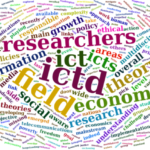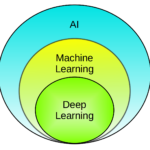Just like the Internet, the origins of Artificial Intelligence (AI) are linked to wars and ensuing military operations. In this case, WWII was the critical catalyst in supporting the research efforts of early pioneers such as Turing, Shannon and Wiener. Building on Turing’s theory of computation and recent developments in mathematical modeling, two academic researchers conceptualized the idea of Neural Networks (NNs) in 1943. Seven years later, the first-ever NN computer, the SNARC, saw the light of day using vacuum tubes and military technology designed for B-24 bombers . It was only in 1956 that the term AI was coined at the now well-known Dartmouth Summer Research Project, which lasted several weeks.
A year earlier, with the Cold War entirely in motion and good old-fashioned colonialism (GOFAC) nearing its much-desired end, 29 countries representing more than half of the World’s population gathered in Bandung, Indonesia. Anticolonialism and peace were two of its clarion calls while reminding the global masters they would not take any orders from them anymore . In July of 1956, in apparent yet unknown competition with the AI longish Dartmouth workshop, Egypt, India and the now split-into-pieces Yugoslavia signed the Brijuni declaration that led to the official creation of the Non-Aligned Movement (NAM) in 1961. Its five core principles included peaceful co-existence, non-aggression, no interference, sovereignty, and territorial integrity. Today, 120 countries are NAM members and recently met in Uganda, where they issued a new declaration. The spice of the early days is now long gone, that is for sure. Notably, the declaration has little to say about digital technologies – never mind AI.
Interestingly, AI research and the global anti-colonial movement started almost simultaneously, which could be seen as a harbinger. More so when we start thinking about decolonizing AI. But before we take that unique dive, we need to begin with its apparent antagonist, GOFAC.
A vast literature on the subject is already available, and I will certainly not try to summarize it here. For my purposes, a birdseye view will suffice. First and foremost, colonialism entails an unequal power relationship between countries and nations, the former having the upper hand for various reasons, including economic and military power. It also entails the oppression, usually distributed via sheer violence, of those being colonized. In the case of GOFAC, we find already centralized European nation-states conquering nations and territories where states were either weak or absent. The fact that such nations faced internal disputes for local state control, violent in many instances, facilitated the advance of colonialism as alliances between colonial powers and local communities fighting each other were possible. Colonialism thus transcends binary thinking. It is a little more complicated than that.
In any case, GOFAC was propelled by the UK’s and Europe’s capitalist development and its incessant search for new markets, raw materials, wealth, and even labor. It thus had different faces that varied according to the colony’s relevance in the colonial power’s global value chains. The higher its significance, the deeper the degree of colonial control, usually supported by settler colonialism. In any event, colonialism is a multidimensional phenomenon that comprises economic, social, political, and cultural elements that act in concert in both the colonies and the so-called home countries.
GOFAC’s death in the 1960s, give or take a few years, brought forward NAM as a political movement and triggered the development of postcolonial, neocolonial, and decolonial schools of thought. Again, much literature on these and the various debates is readily available. Simplifying a bit, while both postcolonialism and neocolonialism explore the impact of and continuation of colonialism in a different disguise, decolonial thought directly challenges Eurocentrism (or Westerncentrism, as other countries have joined such a club), perhaps best depicted in Hegel’s astounding, yet flawed Philosophy of History.
Decoloniality also questions so-called “rational” thought and calls for directly addressing the devastating effects of colonialism and the “modern” era. It also questions the Enlightenment, yet again, but this time from the perspective of the colonized. In 1947, Adorno and Horkheimer developed their Enlightenment critique by focusing on Fascism, totally ignoring the irrationality of colonial powers violently oppressing multiple nations around the globe for centuries in the name of “progress.” That is almost the same as missing the deciding penalty kick in the World Cup Final. Here, Eurocentrism is entirely at work, yet again. Fortunately, Enrique Dussel has already written a decolonial philosophy of history . In any case, decoloniality is a critical theory of colonialism with a defined epistemological domain and specific social practices at the local level.
That is the context into which we need to now introduce AI. For starters, we must agree that AI is a sui generis digital technology. While it has indeed been propelled by rapid advances in Information and Communications Technologies (ICTs) and computer science, it has a well-defined and distinct personality. Iits main goal is to create (semi) autonomous computational agents that can successfully undertake various human tasks with above-average skills. Its latest incarnation, Generative AI, can indeed create new content while displaying other human-like traits. Second, AI should be seen as a series of technologies that encompass symbolic AI (good old-fashioned AI, GOFAI), Machine Learning (ML) and Deep Learning (DL). Each is associated with a series of specific algorithms deployed to create a gamut of AI models and applications. And while the algorithms are quite different, they can be used to develop similar applications. Chatbots are a good example, with platforms such as ChatGPT, Bard, and Claude now soundly beating older chatbot AI models.
Last but not least, AI’s overall production process must be factored into the analysis. Production itself seems limited to a few geographies and is essentially concentrated in two countries now fiercely competing. However, the most globally successful AI applications have one distinct nationality. The global distribution of AI depends on old or new platforms and requires acceptable Internet connectivity. However, AI can also be distributed indirectly via other digital channels and reach all those without fast Internet connectivity or are simply disconnected. That is certainly the case for countries at the bottom of the income and wealth pyramids. Looking at AI’s production also unveils critical governance asymmetries between producers and consumers. Curiously, the European Union (EU) seems to be in the same boat as most other Global South countries as it has been unable to develop its own AI sector. However, unlike most others, the EU has the institutional and fiscal capacity to rein in AI and other digital technologies, as the record shows.
With that in mind, we should expect AI to have a profound socio-economic, political, and cultural impact in the former colonies, just like GOFAC did, but without using violent means to advance its agenda. By default, we should also expect AI to maintain and even deepen the asymmetries noted above unless we collectively agree to decolonize it.
Thus, we need to take the bull by its horns and not just dance around it – or run away, scared.
Raúl
References






